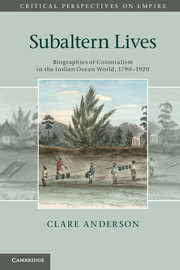3 - George Morgan
Published online by Cambridge University Press: 05 June 2012
Summary
George Morgan: Trade: Cook and servant – Height: 5/8½ – Age: 27 – Complexion: Black – Head: Round – Hair: Black – Whiskers: None – Visage: Long – Forehead: Low – Eyebrows: Black – Eyes: Black – Nose: Wide – Mouth: Wide, thick lips – Chin: Wide – Native Place: Calcutta – Remarks: A black.
On 17 April 1838 two men, George Morgan and George Lloyd, appeared before the Supreme Court of Calcutta, charged with assaulting one William Tipping on the public street and stealing his musical snuffbox. The court found both men guilty; because the stolen property was so valuable – it had an estimated value of 14 rupees – it sentenced them to seven years’ transportation each. Lloyd was ordered to Van Diemen's Land, a British and Irish penal colony in Australia. Morgan's destination was the East India Company's Indian penal settlement in Burma's Tenasserim Provinces. The newspaper reporting the trial, The Calcutta Courier, noted that Morgan's ‘demeanour had all along been very contemptuous’. On leaving the courtroom he had, apparently, ‘thanked his lordship’.
- Type
- Chapter
- Information
- Subaltern LivesBiographies of Colonialism in the Indian Ocean World, 1790–1920, pp. 56 - 92Publisher: Cambridge University PressPrint publication year: 2012



